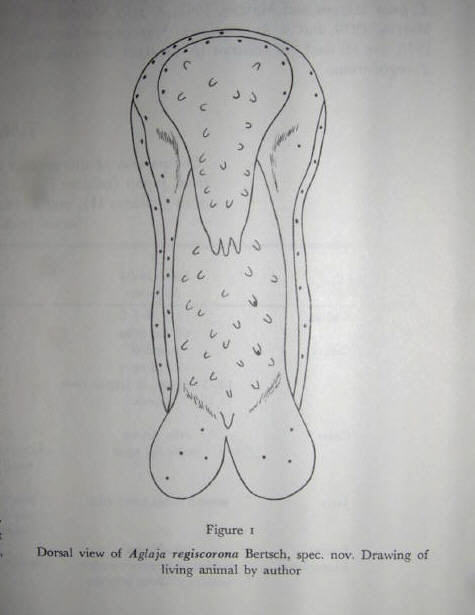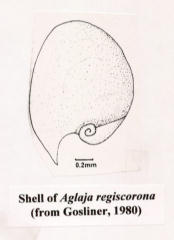 |
Aglaja regiscorona
Line Drawing courtesy of Dr. Hans BertschThis species of Cephalaspidean is certainly one of the rarer of tropical west American opisthobranchs. It is known only from 7 specimens, which I collected intertidally on 19-22 July 1969, at Bahía Las Cruces (24 13' N; 110 05' W), Baja California Sur, México. These specimens (one holotype and 6 paratypes) have been deposited in the collections of California Academy of Sciences and the Los Angeles County Museum of Natural History. To my knowledge, they have not been collected since I found the type material. The only references are my original description, and internal anatomical descriptions in Gosliner (1980). Both I and Orso Angulo Campillo have made numerous efforts to find specimens of this species.
My photographs of the original animals are extremely poor, so reproduced here is the original line drawing published in the description of the species, and a scanning electron micrograph of the shell.
The specimens varied in total length from 3 to 5 mm, and were 1.25 to 1.75 mm in width. The body color is a cream white, with the dorsal center a darker dirty white (verging on a light greenish-brown). The edges of the posterior lobes are transparent white. The frontal margin of the cephalic hood, and the edges and sides of the parapodia have numerous small black flecks; the posterior lobes also have some black spots. The dorsum and cephalic shield are covered with numerous papillae, some tipped with black (see line drawing).
Head shield triangular, projecting posteriorly and upwards to a small, three-pointed crown. The species name is Latin for "King's crown," in reference to this highly distinctive cephalic shield which resembles a royal crown! The parapodia are small, held tightly against the sides of the body, and do not extend over the dorsal surface. Two lobes project from the rear, neither with an extending flagellum.
The calcified shell is 0.55 mm long. The nuclear whorl is 0.18 mm wide. Nucleus of shell has one complete whorl, and a small flange projects laterally at a right angle to the plane of the whorl. Small ridges, separated by a slight notch, circle the lateral edge of the whorl. The wing bends sharply vertically to plane of nuclear whorl, and folds again nearly parallel to the plane of the whorl.

Furthermore, Dr. Gosliner wrote, "Ventral labial gland larger than dorsal gland. Pharynx 1.4 mm, bulbous, muscular. Central nervous system without separate genital ganglion. Reproductive system with receptaculum seminis entering hermaphroditic duct near the middle of its length. Penis complex with two distinct prostatic portions, different in shape and texture. Penial papilla club-shaped, unarmed." |
References:
Bertsch, Hans. 1972. Two additions to the opisthobranch fauna of the southern Gulf of California. The Veliger 15 (2): 103-106.
Gosliner, Terrence M. 1980. Systematics and phylogeny of the Aglajidae (Opisthobranchia: Mollusca). Zool. J. Linn. Soc. 68 (4): 325-360.
Hans Bertsch
Imperial Beach, CA
Jan., 2003

|
Imperial Beach, CA 91932
FAX (619) 423-9118
Send Hans E-Mail at hansmarvida@cox.net
